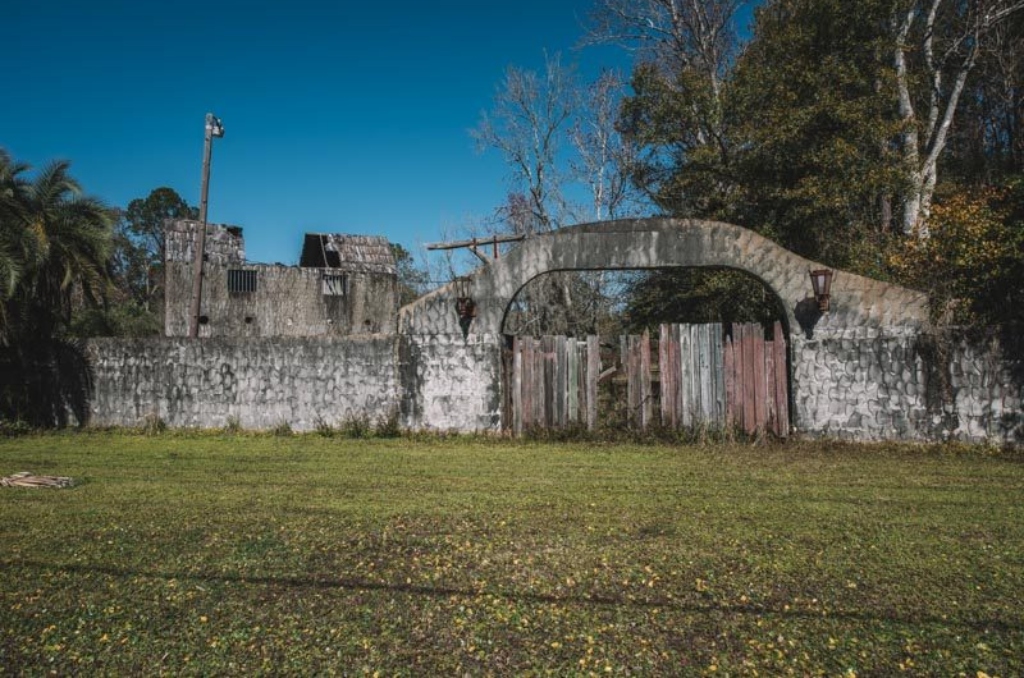Fort Bengali. Photo: Bullet, www.abandonedfl.com
1. Fort Bengali in St. Augustine, Florida
This now-abandoned former jail first opened in the late 1950s by L.H. “Buddy” Hough as the “Oldest Jail.” This forced fellow local man Henry “Slim” McDaniel to rename his tourist attraction “The Authentic Oldest Jail”, the well-preserved Victorian jailhouse on San Marco Avenue. In the 1970s, the attraction was renamed “Fort Bengali” and reverted back to its original known name of “Old Jail.”
Located on Hough’s property was a one-sixth scale model train and the jail attraction had several cast-iron lanterns. The lanterns once adorned the Bridge of Lions before the Florida Department of Transportation (FDOT) replaced it with aluminum lanterns. Some of the lanterns remain there to this day.
2. Old Spanish Monastery in North Miami Beach, Florida
Construction of the Monastery of St. Bernard de Clairvaux began in the year 1133 AD in Sacramenia, near Segovia in northern Spain. Completed eight years later in 1141, the Monastery was dedicated to the Blessed Mother and was originally named ‘The Monastery of Our Lady, Queen of the Angels.’ Upon the canonization of Bernard of Clairvaux in 1174, the Monastery was renamed in his honor.
In 1925, William Randolph Hearst purchased the Cloisters and the Monastery’s outbuildings. The structures were dismantled stone by stone, bound with protective hay, packed in more than 11,000 wooden crates, numbered for identification and shipped to the United States. Due to Hearst’s financial problems that would later arise, his assets were later sold at auction (including the Monastery).
One year after Hearst’s death in 1952, they were purchased by two entrepreneurs for use as a tourist attraction. It took 19 months and the equivalent of nearly $20 million dollars (in today’s currency) to put the Monastery back together.
Today the parish Church of St. Bernard de Clairvaux is an active and growing congregation in the Episcopal Diocese of Southeast Florida. Services are held on Sundays and weekdays in both English and Spanish.
3. A World of Orchids in Kissimmee, FL
A World of Orchids was a working greenhouse located in Kissimmee. The greenhouse contained within it all kinds of exotic plants and orchids, in a controlled humid environment, complete with waterfalls, streams and ponds full of fish, and parrots which flew overhead. A 1000-foot-long boardwalk was also located behind the property which trailed off into the wetlands.
The opening day in the summer of 1992 was delayed due to construction. In August 1992, Hurricane Andrew swept through South Florida. The hurricane was a Category 5 and destroyed the nursery in Miami that held the plants and flowers for the Kissimmee greenhouse. Plants were packed into trucks and shipped to Kissimmee. Once there, members of the cultural study group of the Central Florida Orchid Society were ready to provide help to thousands of needy plants and flowers.
The park’s new opening date was set for March 13, 1993. Volunteers from the Orchid Society decided to stay to provide help and tend to the battered plants.
In 2004, Hurricane Charley made landfall as a Category 4 in Florida, making it the strongest hurricane to hit the United States since Hurricane Andrew in 1992. World of Orchids suffered severe damages. Part of the roof of the greenhouse was lost as a result and the roof remained unrepaired due to lack of funds for its replacement and no insurance.
The greenhouse was left in shambles (where it still remains to this day) but the shops remained open, selling and shipping out orchids. Complaints from visitors, though, forced the greenhouse to be closed for good.
There are still plants that remain growing wildly in the humid Florida weather and there are still some small fish that can be found swimming in the murky waters. World of Orchids officially closed on July 15, 2012. A sign was left on the door indicating they would be moving to a new location (new location is currently unknown).
4. Burdines Department Store in Miami, Florida
If you were a young child in Florida in the 90s, chances are you may have visited the Burdines Department Store once or twice in your life with your mother or another adult.
Burdines was a department store chain operating in Florida with its main store located in downtown Miami on West Flagler Street.
Burdines dates back to 1897 when Henry Payne and William M. Burdine opened a dry goods store in Bartow, Florida. Payne left the business a year later, and Burdine brought in his son, John, as a partner and changed the name of the company to W.M. Burdine and Son.
The former Burdines store in downtown Miami operated under Macy’s name until 2018 when it was closed down due to Macy’s restructuring campaign of its stores. In August 2019, it was announced that a construction permit was finalized for a new Ross store in the building as one of their current stores located nearby is scheduled to be demolished.
5. Redland Coral Castle House in Homestead, Florida
According to some locals, construction of the house was inspired by the sculpture garden of the same name built by Latvian immigrant Edward Leedskalnin; some local residents even claim that Leedskalnin himself built the house. However, Edward Leedskalnin did not move to Homestead until 1936, four years after this home was built.
The property, which included a two-bedroom, two-bathroom remodeled home, a large workshop, a separate office/efficiency unit and the Coral Castle house was sold on March 2, 2015, for an estimated $1 million. Today, the property is used by Rancho Grande Castle Rock Farm & Nursery. As for the Coral Castle house, it’s still standing and used by the ranch for portrait photos.
Melissa’s career in writing started more than 20 years ago. Today, she lives in South Florida with her husband and two boys.

